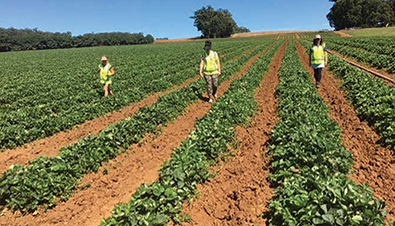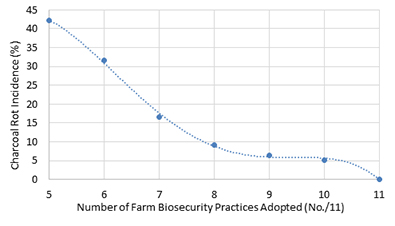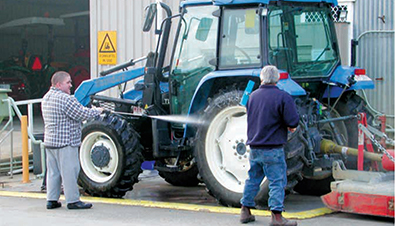Read the latest information on
Foot-and-mouth disease

Staff from the Victorian Strawberry Industry Certification Authority (VSICA) inspecting strawberry runners for pests and diseases. Photo credit: VSICA
Disease causing organisms found in the soil can be very difficult and expensive to control or eradicate. For many, once they are on a farm, they are there to stay.
Producers are often advised to use biosecurity practices to minimise the risks posed by pests and diseases that are found in soil. But how do you know if they work?
Researchers* recently surveyed growers to find out how effective biosecurity practices were at controlling a soil-borne disease of strawberry.
Although the results are for one disease on one crop, they clearly demonstrate the benefits to be had from using simple biosecurity measures on your farm.
Soil-borne pathogens cause diseases that stunt and/or kill strawberry plants. They are widespread across the globe and cause severe economic losses each year.
In Australia, charcoal rot, Fusarium wilt and Phytophthora crown rot are some of the most devastating soil-borne diseases of strawberry and have increased in importance since the phase-out of the fumigant methyl bromide. Based on a survey of the Victorian strawberry industry in 2020, charcoal rot killed 15 per cent of plants and cost the industry $15 million.

Association between the number biosecurity practices (out of 11) adopted by strawberry growers on their farms in Victoria in 2020-21 and the incidence of charcoal rot in their crop. Note: no growers had adopted fewer than five of the eleven farm biosecurity practices.
In 2020–21, the researchers surveyed 77 strawberry growers in Victoria about their farm biosecurity practices. They then measured the incidence of charcoal rot and the amount of the fungus Macrophomina phaseolina that causes the disease on their properties.
Results showed there was a strong association between the number of farm biosecurity practices used by growers and charcoal rot in their crops. Growers who used more practices had less M. phaseolina and charcoal rot.
Charcoal rot had also decreased by 20 per cent across Victorian strawberry farms in 2020–21, compared with 2017.
The researchers suggest that as more strawberry growers adopt more biosecurity practices, there will be less spread of diseases, pests and weeds across the industry.
The strawberry growers were using the following biosecurity practices:

Growers cleaning a tractor with high pressure water to remove soil, in a designated washdown location. Photo credit: VSICA
Limiting vehicles to designated areas on your property helps to contain any infested soil they may carry. Car parks can also help to control the movement of visitors and staff on your property.
* Dr Dylan McFarlane and Dr Scott Mattner of VSICA Research and Yilin He from YunNan LuFeng QuinPan Agri-Dev. Co.
Edited, with permission, from an article that originally appeared on page 81 of Edition 7, Winter 2021, of the Australian Berry Journal.
The authors acknowledge funds from the Australian Government, VSICA Research Pty Ltd and YunNan LuFeng QuinPan Agri-Dev. Co. Ltd to support collaborations between Australian and Chinese businesses. They thank the strawberry fruit growers in Australia and China for providing plant and/or soil samples, and their time.